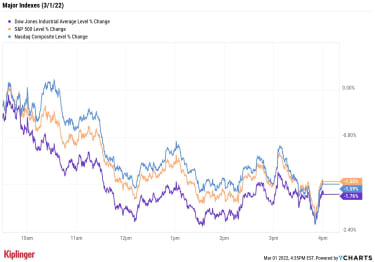The major market benchmarks opened lower and losses accelerated amid reports that Russia is targeting civilian areas in Ukraine, including Kharkiv, the country’s second-largest city. Additionally, after warning of “high-precision strikes,” Russian forces on Tuesday hit a TV tower in Kyiv.
“The crisis in Ukraine is evolving rapidly, and with it so are investor expectations for international relations, commodity prices, inflations, the corporate operating environment and company margins,” says Lauren Goodwin, economist and portfolio strategist at New York Life Investments.
“As the crisis unfolds, equities could bounce if developments point to contained conflict and lighter sanctions, while equities could deteriorate in moments of escalation.”
Today, stocks crumbled as the attacks intensified, with financials (-3.7%) the worst-performing sector amid notable losses in blue chips American Express (AXP, -8.5%), Goldman Sachs (GS, -3.2%) and JPMorgan Chase (JPM, -3.8%).
Not surprisingly, the Dow Jones Industrial Average (-1.8% at 33,294) was the biggest decliner, followed by the S&P 500 Index (-1.6% at 4,306) and the Nasdaq Composite (-1.6% at 13,532).
Sign up for Kiplinger’s FREE Investing Weekly e-letter for stock, ETF and mutual fund recommendations, and other investing advice.
One bit of encouraging news today was this morning’s Institute for Supply Management’s (ISM) manufacturing purchasing manager’s index (PMI), which rose to a higher-than-expected 58.6 in February.
“Manufacturing growth was solid in February, the inflation-sensitive prices component dipped on the month, and the index component reflecting supplier delivery performance noted better supply chain conditions than in January and December,” says Bill Adams, chief economist for Comerica Bank.
“Falling coronavirus cases should help the domestic side of the economy improve further in the spring months, but spillover from higher energy and food prices and international shipping disruptions related to the Russia-Ukraine war are a downside risk to manufacturing near-term,” he adds.
YCharts
Other news in the stock market today:
The small-cap Russell 2000 gave back 1.9% to end at 2,008.Gold futures spiked 2.3% to settle at $1,943.80 an ounce.Bitcoin rallied 5.5% to $44,252.28. (Bitcoin trades 24 hours a day; prices reported here are as of 4 p.m.)Target (TGT) jumped 9.8% after the big-box retailer reported adjusted earnings of $3.19 per share and revenue of $31 billion in its fourth quarter, beating analysts’ estimates for earnings of $2.86 per share and sales of $31.4 billion. TGT also offered up higher-than-expected guidance for the upcoming fiscal year. “TGT continues to find ways to keep traffic and sales momentum strong, which is allowing the retailer to continue making investments in price, labor, etc. while also growing the bottom line,” says CFRA Research analyst Arun Sundaram (Buy). “Fiscal 2023 results will be choppy quarter-over-quarter, but should generally get better as the year progresses.”Foot Locker (FL) fell 7.6% after B. Riley analyst Susan Anderson downgraded the athletic apparel retailer to Neutral (Hold) from Buy and slashed her price target by $30 to $34 (FL closed today at $29.23). “We believe FL will be in a transition phase for at least a year as their exposure to Nike (NKE) is lowered, which creates limited visibility on future sales/margins,” Anderson writes. “This transition could open up ~$900M in shelf space annually which we expect will benefit other footwear and apparel manufacturers including Crocs (CROX), New Balance and Adidas, but will create a void for FL until that space can be filled.”Why We’re Still Watching InflationOil prices, on the other hand, swung notably higher in today’s trading, even after the International Energy Agency (IEA) agreed to release 60 million in emergency crude reserves.
U.S. crude futures were up more than 11% at their session peak before finishing up 8% at $103.41 per barrel – their highest settlement since July 2014. And these rising energy prices could keep the fire burning under already sizzling inflation.
“The Russia/Ukraine conflict is driving oil and other commodity prices higher, which does present the possibility of inflation remaining higher for longer,” says Lindsey Bell, chief investment strategist for Ally Invest. “Medium-term inflation will be important to keep an eye on. Consumer confidence has already taken a hit and a survey by Ally shows that 77% of Americans believe inflation will increase over the next 12 months.”
There are several options for investors looking to mitigate the effects of red-hot inflation on their portfolio, including seeking out high-quality stocks from sectors that are considered more “inflation-proof” than others: consumer staples, utilities and healthcare, for instance. You can also play the hot hand with energy stocks or increase exposure to rising commodity prices with these exchange-traded funds (ETFs). Each of the funds featured here provide investors access to a wide variety of commodities futures and hard assets that can often work as a hedge against inflation.
